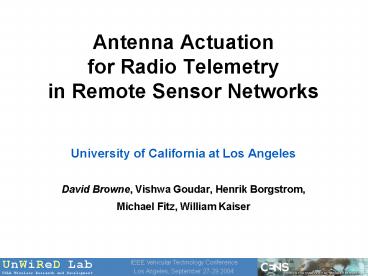IEEE Vehicular Technology Conference PowerPoint PPT Presentation
1 / 17
Title: IEEE Vehicular Technology Conference
1
Antenna Actuation for Radio Telemetry in Remote
Sensor Networks
- University of California at Los AngelesDavid
Browne, Vishwa Goudar, Henrik Borgstrom, Michael
Fitz, William Kaiser
2
Remote Sensor Networks
- Three characteristics
- Nodes deployed sparsely over large geographic
regions - Nodes gather local data on a natural phenomenon
- Nodes need to communicate sensor data
Example UCLA Broadband Seismic Network Array
(Thanks to Igor Stubailo and John Propst for
graphics.)
3
Remote Sensor Networks
- Goal
- Enable telemetry of sensor data between nodes
Known solution Radio telemetry over
omni-directional or sector antenna
- Benefits
- ad hoc deployment
- self assembling
- self healing
- Limitations
- Poor range
- Low energy efficiency
Better solutionHighly-directional antennas with
rotational actuation
4
Benefits of Directional Antenna
- Measured Path Loss 40dB/decade is typical
- Range improvement
- Omnidirectional 80dB loss _at_ 130m
- 15dBi Directional 80dB loss _at_ 750m
- Efficiency improvement
- A link over 15dBi antennas is 1000x more energy
efficient
azimuth
azimuth elevation
5
Actuated Network Assembly
Initial antenna orientation
Antenna orientation after articulation
6
The First Contact Problem
- Missing information
- Direction to other nodes.
- Search coordination
- Energy Considerations
- search depletes energy
- global vs. local maxima
Q How to shorten the first contact search? A
coordination geolocation.
7
Wideband vs. Narrowband Radios
- 802.11b Radio
- 2.44 GHz
- 20MHz Bandwidth
- 100m range (omni)
- UCLA Narrowband Radio
- 220 MHz
- 4 kHz
- 2 mile urban range (omni)
8
Search Strategies
9
Field Test Results
10
Field Test Conclusions
- Blind vs. Geolocation and/or Coordination ?
reduced search duration from 1.5 hours to 15min - Coordination only? search times are independent
of range. - Geolocation only ? excellent short range (0m
500m) search times (10s) ? exponentially
deteriorating performance after 500m - Coordination Geolocation ?excellent range
independent search times (10s)
11
Conclusions on Directional Antenna Actuation
- Benefits common with omni/sector solutions
- ad hoc deployment
- self assembly
- self healing
- Advantages over omni/sector solutions
- range
- energy efficiency
- Disadvantage latency due to actuation
- latency due to actuation ? Importance of
minimizing search time.
12
Whats Next
13
End of PresentationQuestions and Comments
14
Search Algorithms
- A. Blind Search (baseline)
- 802.11b radios search for gtthreshold coordinate.
- Exhaustive search for the global maximum.
- Upper bounds all strategies.
- B. Coordinated Search
- Coordination via LR radios.
- Nodes begin 180º out of phase.
- Nodes complete one rotation.
- Link guaranteed within one rotation.
- Lower bound for coordination.
- C. Blind Search Geolocation
- Random walk (speed dwell).
- 802.11b radios search for gtthreshold coordinate.
- GPS coordinates exchanged over 802.11 radios for
LOS alignment.
- D. Coordination Geololation
- GPS coordinates exchanged over LR radios .
- Immediate LOS alignment.
15
( Coordinates gt Threshold) vs. Range
16
Strategy C Simulation
17
The Link Search Space
- Simulated Link Search Space
Measured Link Search Space

